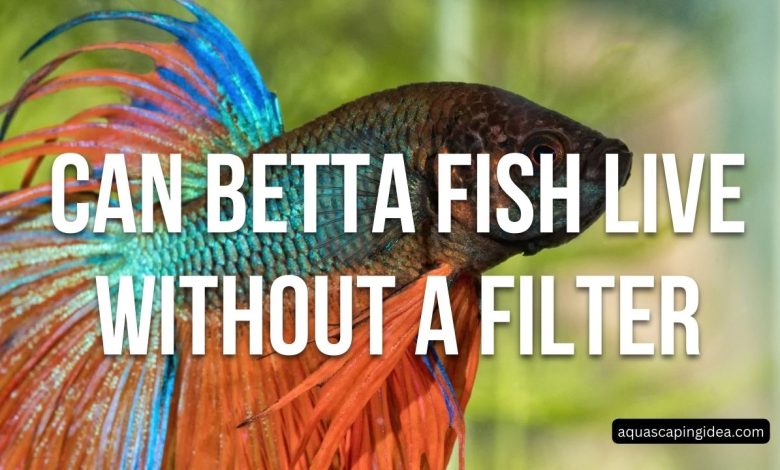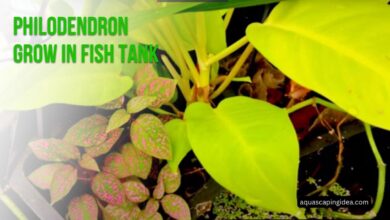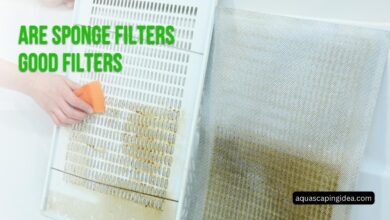Can Betta Fish Live Without A Filter

Captive betta fish live very different lives than their rice paddy ancestors. Small, sterile glass boxes hardly mimic slow moving streams and dense vegetation that evolved these labyrinth fish. One key difference is water flow – or lack thereof – in natural betta habitat. Filters push currents most find too brisk.
While promoting cleanliness, filters also remove beneficial bacteria, disrupt nesting behavior, and stress delicate fins. So can Bettas actually thrive and attain full life expectancy without standard filtration? What factors allow them to exist filter-free? Let’s review how their unique biology enables existence without such support.
Can Bettas Live Without a Filter?
Betta fish can technically survive in a tank without a filter, as they are labyrinth fish that can breathe from the surface. However, it is generally not recommended to keep bettas in an unfiltered environment long-term.
Pros of a Filterless Betta Tank:
- Saves money by not needing a filter
- Avoids strong currents that bettas dislike
Cons of a Filterless Betta Tank:
- Water quality declines more rapidly without filtration
- More maintenance required (frequent water changes)
- Limits tank mates and bioload
- Poor oxygenation without water movement
Importance of Water Quality
Water quality is crucial for betta health and survival. Without a filter, ammonia, nitrites, and nitrates can build up quickly to toxic levels. This requires multiple partial water changes per week to remove waste. Poor water quality stresses bettas, making them prone to diseases and shortening lifespan. Maintaining high water quality is very challenging long-term without a filter to provide biological filtration.
Betta’s Specialized Breathing
Unlike most fish, Bettas posses a special organ allowing them to breathe oxygen directly from air. Called the labyrinth organ, this adaptation lets Bettas survive in low-oxygen conditions with minimal surface agitation. In small volumes, their movements provide adequate circulation without filters.
This anatomical anomaly means Bettas don’t rely solely on oxygen infused from water like other fish. Therefore, vigorous aeration from pumps and excessive water disturbance isn’t necessary in their tanks. Filter-free systems work as long as some surface interaction occurs for gas exchange.
The Nitrogen Cycle without Filtration
Filters house beneficial bacteria that removes waste like ammonia and nitrates from recycled water. This nitrogen cycle is essential for breaking down fish excrement into less toxic compounds. Tanks without filters depend more on manual removal of materials and water changes to reduce nitrates.
Strategically arranged live plants can assist by directly consuming nitrogenous waste while helping oxygenate environments. Snails, shrimp and other cleaners also graze algae and detritus. Combined with careful feeding and 25% biweekly water renewals, unfiltered tanks can sustain balanced ecosystems.
Ideal Conditions for Filterless Setups
To successfully cultivate filter-free systems, follow these guidelines:
- 5+ gallon tanks
- 2x weekly 25% water changes
- Live plants like moss balls and anacharis
- Adjustable heater and thermometer
- Chemical conditioner to remove chlorine
- Natural light to stimulate plant growth
- Varied diet in small amounts
- Gentle water movement via air stone
With vigilance maintaining optimal water quality and nutrition, betta fish can indeed thrive sans filtration for normal lifespans of 3-5 years.
Frequent Water Changes
Without a filter to provide biological filtration, regular partial water changes are essential for a filterless betta tank. Plan on changing 25-50% of the water 2-3 times per week at minimum. During water changes, vacuum the gravel to remove solid waste and uneaten food. Consistent, small water changes help reset ammonia/nitrite levels.
Using Live Plants
Live plants can be very beneficial in a filterless tank. They absorb ammonia/nitrites and provide hiding spots and natural bacteria surfaces. However, be careful not to overstock plants in a small tank. Good options include java fern, anubias, moss balls. Avoid plant species requiring intense light.
Limiting Bioload
In a filterless environment, it’s crucial to limit the tank’s bioload or amount of fish waste produced. A single betta with no tankmates is best. Adding other fish will quickly foul the water. Overfeeding should also be avoided as decomposing food releases ammonia. Feed small amounts that the betta can consume in 2-3 minutes.
Alternatives to Filters
While not as effective as a full filter system, there are some alternatives that can provide beneficial water movement and surface agitation in a betta tank:
Air Stones/Bubblers
An air stone connected to an air pump creates a stream of bubbles rising from the tank bottom. This surface agitation helps gas exchange and oxygenation. However, air stones do not provide any biological or mechanical filtration.
Sponge Filters
A sponge filter is a simple device made of porous sponge material that captures debris. An air pump creates water flow through the sponge. Beneficial bacteria can colonize the sponge to provide some biological filtration. Sponge filters are a good low-flow option for bettas.
Tank Size Requirements
For a filterless betta tank, bigger is better. A minimum of 2.5-3 gallons is recommended, but 5 gallons or more is preferable to dilute waste. Smaller tanks become unstable without filtration.
Cycling the Tank
Even without a filter, it’s still important to cycle or establish the nitrogen cycle in the tank before adding a betta. This allows beneficial bacteria to populate surfaces. Use an ammonia source to cycle.
Monitoring Water Parameters
With no filter, water parameters like ammonia, nitrites, nitrates and pH must be tested regularly (2-3 times per week). Invest in a freshwater test kit. Any ammonia/nitrite readings should prompt an immediate water change.
Other Tips:
- Use a gravel vacuum to remove waste during water changes
- Rinse decorations regularly to prevent algae buildup
- Consider dosing a de-chlorinator/water conditioner with each change
- Perform 25-50% water changes every 2-3 days at minimum
- Avoid overfeeding and remove any uneaten food
Regular maintenance and monitoring is crucial for betta health in an unfiltered setup. With diligence, it can be done, but filtered tanks are generally easier.
FAQs
How often should I change water with no tank filter?
Twice weekly 25% water swaps help reduce waste accumulation. Use water conditioner and match temperature to the tank. Test regularly for spikes indicating more frequent changes.
What size tank usually needs a filter?
Tanks 5-10 gallons and under typically require standard filtration to process waste and circulate water. Use adjustable, low flow systems with protective guards for small tanks housing bettas.
Will my betta fish be okay without a filter?
Yes, with appropriate space (5+ gallons), live plants, routine maintenance, a heater and air stone for oxygenation, bettas can live full lifespans without standard filtration due to their specialized labyrinth breathing organ.
Can I put gravel or sand in a tank without a filter?
Yes, natural substrates help beneficial bacteria colonies grow to process waste. Choose smooth gravel under 3mm diameter or super fine sand. Supplement with live plants and snails to prevent accumulation.
Conclusion
Given their unique anatomy and biology, betta fish can survive just fine without standard filtration as long as keepers provide large volume, live plants, and regular care. While filters assist other fish species, too much current actually stresses delicate bettas. You can help them thrive filter-free by replicating natural slow moving environments through strategic tank additions. With clean, still water and room to build bubblenests, these special fish dazzle filtration-free for years.




